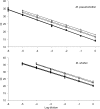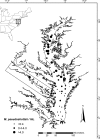Quantitative PCR assay for Mycobacterium pseudoshottsii and Mycobacterium shottsii and application to environmental samples and fishes from the Chesapeake Bay
- PMID: 20656856
- PMCID: PMC2937484
- DOI: 10.1128/AEM.01091-10
Quantitative PCR assay for Mycobacterium pseudoshottsii and Mycobacterium shottsii and application to environmental samples and fishes from the Chesapeake Bay
Abstract
Striped bass (Morone saxatilis) in the Chesapeake Bay are currently experiencing a very high prevalence of mycobacteriosis associated with newly described Mycobacterium species, Mycobacterium pseudoshottsii and M. shottsii. The ecology of these mycobacteria outside the striped bass host is currently unknown. In this work, we developed quantitative real-time PCR assays for M. pseudoshottsii and M. shottsii and applied these assays to DNA extracts from Chesapeake Bay water and sediment samples, as well as to tissues from two dominant prey of striped bass, Atlantic menhaden (Brevoortia tyrannus) and bay anchovy (Anchoa mitchilli). Mycobacterium pseudoshottsii was found to be ubiquitous in water samples from the main stem of the Chesapeake Bay and was also present in water and sediments from the Rappahannock River, Virginia. M. pseudoshottsii was also detected in menhaden and anchovy tissues. In contrast, M. shottsii was not detected in water, sediment, or prey fish tissues. In conjunction with its nonpigmented phenotype, which is frequently found in obligately pathogenic mycobacteria of humans, this pattern of occurrence suggests that M. shottsii may be an obligate pathogen of striped bass.
Figures




Similar articles
-
Elevated temperature inhibits Mycobacterium shottsii infection and Mycobacterium pseudoshottsii disease in striped bass Morone saxatilis.Dis Aquat Organ. 2021 May 6;144:159-174. doi: 10.3354/dao03584. Dis Aquat Organ. 2021. PMID: 33955854
-
Nested polymerase chain reaction assay for detection of Mycobacterium shottsii and M. pseudoshottsii in striped bass.J Aquat Anim Health. 2008 Dec;20(4):192-201. doi: 10.1577/H07-037.1. J Aquat Anim Health. 2008. PMID: 19306608
-
Expanded range and new host species of Mycobacterium shottsii and M. pseudoshottsii.J Aquat Anim Health. 2009 Sep;21(3):179-83. doi: 10.1577/H09-005.1. J Aquat Anim Health. 2009. PMID: 20043404
-
The evolving story of Mycobacterium tuberculosis clade members detected in fish.J Fish Dis. 2006 Sep;29(9):509-20. doi: 10.1111/j.1365-2761.2006.00744.x. J Fish Dis. 2006. PMID: 16948700 Review.
-
Mycobacteriosis in fishes: a review.Vet J. 2009 Apr;180(1):33-47. doi: 10.1016/j.tvjl.2008.05.012. Epub 2008 Jul 11. Vet J. 2009. PMID: 18620877 Review.
Cited by
-
Importance of Local and Regional Scales in Shaping Mycobacterial Abundance in Freshwater Lakes.Microb Ecol. 2018 May;75(4):834-846. doi: 10.1007/s00248-017-1088-6. Epub 2017 Oct 23. Microb Ecol. 2018. PMID: 29063147
-
First isolation of Mycobacterium spp. in Mullus spp. in Turkey.Iran J Vet Res. 2015 Spring;16(2):144-9. Iran J Vet Res. 2015. PMID: 27175166 Free PMC article.
-
Identification Mycobacterium spp. in the Natural Water of Two Austrian Rivers.Microorganisms. 2020 Aug 27;8(9):1305. doi: 10.3390/microorganisms8091305. Microorganisms. 2020. PMID: 32867056 Free PMC article.
-
Genomic Degeneration and Reduction in the Fish Pathogen Mycobacterium shottsii.Microbiol Spectr. 2022 Jun 29;10(3):e0115821. doi: 10.1128/spectrum.01158-21. Epub 2022 May 17. Microbiol Spectr. 2022. PMID: 35579461 Free PMC article.
-
Mycobacterium pseudoshottsii in Mediterranean Fish Farms: New Trouble for European Aquaculture?Pathogens. 2020 Jul 27;9(8):610. doi: 10.3390/pathogens9080610. Pathogens. 2020. PMID: 32726963 Free PMC article.
References
-
- Blazer, V., W. K. Vogelbein, C. Densmore, D. Zwerner, and E. B. May. 1999. Ulcerative skin lesions in menhaden from Chesapeake Bay. J. Aquat. Anim. Health 11:340-349.
-
- Bruno, D. W., J. Griffiths, C. G. Mitchell, B. P. Wood, Z. J. Fletcher, F. A. Drobniewski, and T. S. Hastings. 1998. Pathology attributed to Mycobacterium chelonae infection among farmed and laboratory-infected Atlantic salmon Salmo salar. Dis. Aquat. Org. 33:101-109. - PubMed
Publication types
MeSH terms
Substances
Associated data
- Actions
- Actions
LinkOut - more resources
Full Text Sources
Molecular Biology Databases

